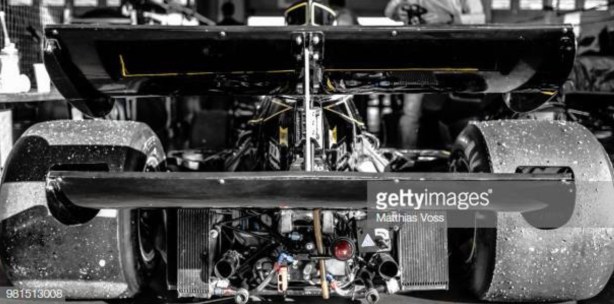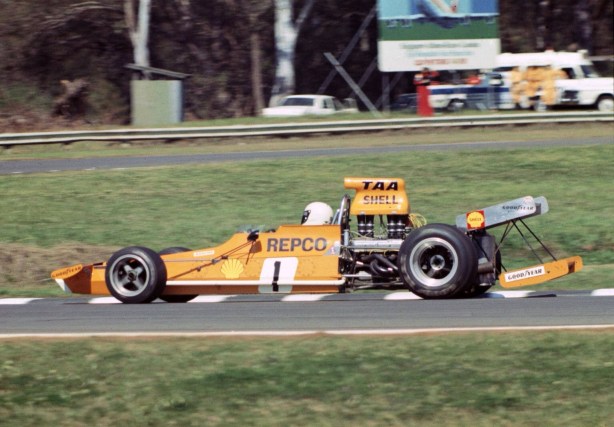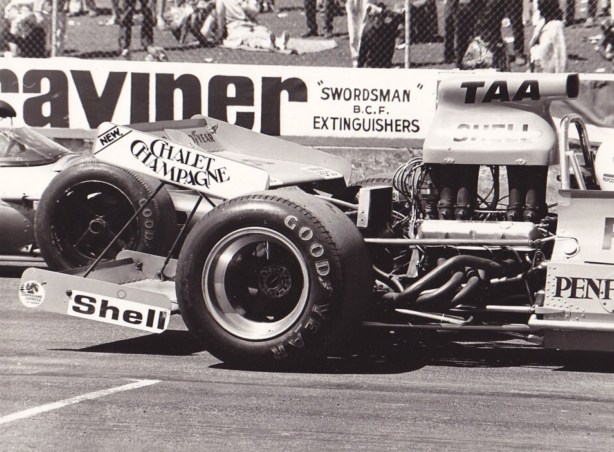Frank Matich’s ‘exhaust blown diffuser’ 1972 style, Matich A50 Repco F5000, on the way to victory in the Hordern Trophy, Warwick Farm 5 November …
Sydney based Team Matich may have been relatively small but they were well funded by virtue of support from Repco, Goodyear, Shell and others depending upon the season.
Nobody did more testing in Oz than FM, it was part of his Goodyear contract after all.
He was a deep thinker too.
The engineering, development and conceptual design of Frank’s cars- from the customer Lotus 19’s, Brabham BT7A and Elfin 400 to the Matich team constructed SR3 and SR4 sports cars and A50-A53 series of six F5000 cars were his and a function of racing the cars at the highest level. His testing abilities were the equal of any of the contemporary driver/engineers on the planet too- Brabham, McLaren, Hall, Gardner, Bennett, McRae, Ganley etcetera.
Therefore Matich had the ability to not only come up with new ideas or set-up directions but analyse the impact of them on the car and determine any further changes which may have been required to optimise the explored direction of the day.
FM was always trying ‘stuff’ in an effort to seek the ‘unfair advantage’.
Derek Kneller, FM’s chef mechanic and confidant throughout the Matich F5000 years recalls how the experimentation came about.
‘Frank had been in the ‘States and watched a Goodyear tyre test at Ontario Motor Speedway in early 1972. When he arrived back he told me he had observed a driver called Jim McElreath testing his car with a very low mounted rear wing.’ (Jim McElreath raced an Eagle 72 Offy in USAC racing in 1972- a guess is that MAY be the car Frank spotted being tested at Ontario)
‘He came down to the workshop (in Sydney) and took our spare wing and placed it one two-gallon oil cans that he placed on their sides behind his A50. He then told me to make some mounting brackets so that we could run the car in that position.’
‘We mounted the wing as Frank requested and did some static tests to prove that the wing would be secure and would be able to transmit the load to the chassis without breaking.’

A50 Repco, Derek Kneller with hands on hips, Frank Matich and a good view of the wings and location of the exhausts during the 1973 Tasman Series in NZ (D Kneller/B Sala)
‘The first test for the car with the lower wing mounted lower down was a tyre test at Surfers.
We covered the car and wing with tufts of wool to assess the air-flow over the car and wing. Frank drove the car on the track around the track with me filming the car from our hire car which was being driven by one of the other team members.
Frank also got me to drive the A50 while he followed in the hire car so he could see for himself what was going on, obviously the speed was much reduced and the car was filmed from both sides.’
‘After two days of testing Frank determined there was a benefit from running the wing, he felt he could enter the main straight at a higher speed due to more downforce making the car more stable, we had been reducing the angle of the main (upper) wing and picking up more speed along the straight. We ended up a second under our lap time from the previous Tasman race earlier in the year.’
‘To be honest we didn’t know exactly how we gained the time, but from what we now know about blown diffusers we must have been getting downforce when Frank was on the throttle with the exhaust blowing over the lower rear wing as he powered onto the straight at Surfers. We then were always running far less angle of attack on the main rear wing than our other competitors’ Derek concluded in what is a fascinating slice of aerodynamic racing history.
Aerodynamic Developments Which Followed…

1974 Lotus 76 Ford DFV- the innovative car incorporated an electronic clutch and bi-plane rear wing but was not a success in the hands of Ickx and Peterson, the venerable 72 was updated again for 1975 (Getty)
I’m not suggesting Matich fully understood what he was exploring, nor is Derek Kneller, but explore it he did, with the result felt by Matich and reflected on the stopwatches.
His two Matich A51’s were so equipped throughout the US L&M Championship in 1973.
That series, very well covered by the global motor racing media is probably where Colin Chapman first saw the approach and thought ‘Hmmm, lets have a look at that for 1974’, mind you he only applied half of the Matich approach- the two wings, not the exhaust blowing the wing.
Lets not forget that Matich made these changes two years before Colin Chapman followed suit with his 1974 F1 Lotus 76 Ford DFV.
McLaren tried the twin-wing set up as well, albeit a couple of years further on.
Here Jochen Mass’ M23 Ford is so equipped at Monaco in 1976, the flatness of setting of the lower wing clear. They didn’t persevere with the approach.
Even the F2 boys gave it a go.
Jean Pierre Jabouille’s team built the Elf 2J Renault 2-litre V6 machines raced by he and Michel Leclere in the 1976 European F2 Championship; a title won by JPJ, a later GP winner with Renault. Here, above, Leclere is running a twin-wing set up during the Pau GP that June. Not so long after McLaren’s Monaco experiments but ages after Matich!
FM was even further ahead of his time, in that the first ‘exhaust blown diffuser’ is generally acknowledged to be the 1983 Renault RE40 Turbo, the conception of which was that of Jean Claude Migeot.
He placed the exhausts and turbo-wastegate flow directly into the diffuser. Before this everyone had routed the exhausts into the area of least influence, usually above the gearbox or with long pipes through the rear suspension or in the cars of the early to mid 1970’s between the upper and lower suspension links or above the top links- between the wing and suspension top link.
At least one racing historian, Gordon McCabe, believes that whilst Renault were the first to blow their exhausts into the diffuser, ‘…exhaust blown diffusers include not only those which blow into the diffuser, but also those which blow over the top of it…and it could be argued that the first such device appeared on the 1982 McLaren MP-4B…’
Etcetera…
Matich on the way to victory in the third round of the Gold Star, the Glynn Scott Memorial Trophy, at Surfers Paradise in late August 1972.
He won four of the six Australian Drivers Championship rounds that year- the Victoria Trophy at Sandown in April, the Belle Magazine Trophy at Oran Park in June, here at Surfers, and the Hordern Trophy at home, Warwick Farm, in November. He did not contest the Symmons, September round.
FM ‘shared the love’ in terms of development items on the A50 with his local customer, John Walker.
Here his twin-wing A50 Repco is shown in the US during the 1973 L&M Championship, I am uncertain as to circuit.
Additional Reading…
Matich F5000 cars; https://primotipo.com/2015/09/11/frank-matich-matich-f5000-cars-etcetera/
Exhaust blown diffusers; checkout this detailed article on the formula1 dictionary site; http://formula1-dictionary.net/diffuser_blown.html and here on ‘McCabism’; http://mccabism.blogspot.com/2012/06/first-ever-exhaust-blown-diffuser-in-f1.html
Bibliography…
Derek Kneller
Photo and other Credits…
Tony Glenn, Mark Pearce, Derek Kneller, Bryan Sala, Tom Rosenthal, Getty Images, Giorgio Piola, MotorSport Images
Tailpiece…Mark Pearce has captured FM beautifully during the 1973 Warwick Farm 100 Tasman Round…
No doubt the aerodynamicists amongst you will be able to interpret the effectiveness of the wing configuration based upon your analysis of the vortices of water produced on that soggiest of days- the event was won by Steve Thompson’s Chevron B24 Chev, aided by some trick Firestone wets, only a smidge, less than two seconds, from Matich.
Finito…











The second photo showing Bob Muir in a McLaren M10, whose car was that as I don’t recall Muir owning one?
Terry,
Warwick had that shocker of an accident at Surfers in his T300 in 1973 as you know. The team missed WF but ran Bob at both Sandown and Adelaide- the ex-Allen spare tub was the M10B raced by Alan Hamilton in 1971, sold to Pat Burke and raced by WB throughout 1972. WB made his comeback in the car later in 1973 after which it was sold to Bryan Thomson- then Volksrolet et al…
Mark